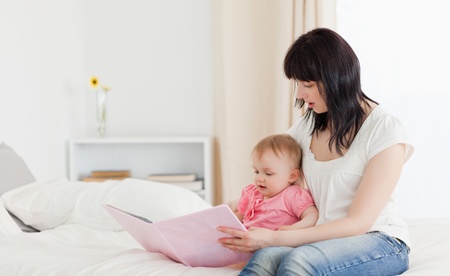1. Creating a Safe and Comfortable Nursery
Preparing a nursery for your newborn is an exciting part of getting ready for parenthood. Your babys room should be both safe and cozy, providing a peaceful environment for sleep and bonding. Here are some essential tips to help you set up the perfect nursery.
Choosing the Right Crib and Mattress
A crib is one of the most important purchases for your baby. It should meet current safety standards and be free from any loose parts or sharp edges. When selecting a mattress, ensure it fits snugly inside the crib without gaps where your baby could get stuck.
| Feature | Recommendation |
|---|---|
| Crib Safety | Look for cribs that meet U.S. Consumer Product Safety Commission (CPSC) standards, with slats no more than 2 3/8 inches apart. |
| Mattress Firmness | Choose a firm mattress to reduce the risk of Sudden Infant Death Syndrome (SIDS). |
| Bedding | Avoid pillows, blankets, and stuffed animals in the crib to prevent suffocation hazards. |
Ensuring Proper Room Temperature and Lighting
The nursery should be kept at a comfortable temperature—between 68-72°F (20-22°C). A too-warm or too-cold room can affect your babys sleep quality. Use a thermometer to monitor the temperature and dress your baby in light layers.
Tips for Maintaining a Comfortable Nursery Temperature:
- Avoid placing the crib near windows, vents, or direct sunlight to prevent drafts or overheating.
- A fan can improve air circulation and reduce the risk of SIDS.
- If using a heater or air conditioner, check that its not making the room too dry or humid.
Selecting the Best Lighting for Sleep
Your babys sleep environment should have soft lighting that mimics natural day and night cycles. Consider blackout curtains to block outside light during naps and nighttime sleep.
Lighting Tips:
- Dimmable lights: A dimmable lamp allows you to adjust brightness for nighttime feedings without fully waking your baby.
- Nighlight placement: Place nightlights away from the crib to provide gentle illumination without being too bright.
- Avoid blue light: Blue light exposure before bedtime can interfere with melatonin production; opt for warm-colored bulbs instead.
A well-prepared nursery will help create a secure and peaceful space for your newborn, making those first few months more comfortable for both you and your baby.
2. Stocking Up on Newborn Essentials
As you prepare for your little ones arrival, its important to stock up on newborn essentials to ensure a smooth transition into parenthood. From diapers to feeding supplies, having the right items on hand will make those first few months much easier. Below is a checklist of must-have baby essentials.
Diapering Essentials
Newborns go through a lot of diapers each day, so its best to have plenty stocked up before your baby arrives.
| Item | Quantity |
|---|---|
| Newborn diapers | At least 2-3 packs (or cloth diapers with inserts) |
| Baby wipes | A few large packs |
| Diaper rash cream | 1 tube |
| Changing pad | 1-2 |
| Diaper pail with liners | 1 |
Clothing Basics
Your newborn will need soft and comfortable clothing that is easy to put on and take off.
| Item | Quantity |
|---|---|
| Bodysuits (onesies) | 6-8 |
| Pajamas or sleepers | 4-6 |
| Socks or booties | 4-6 pairs |
| Mittens (to prevent scratching) | 2-3 pairs |
| Hats (for warmth) | 1-2 |
| Swaddle blankets | 3-4 |
Feeding Supplies
The feeding essentials youll need depend on whether youre breastfeeding, formula feeding, or both.
| Item | If Breastfeeding | If Formula Feeding |
|---|---|---|
| Bottles with nipples | A few for pumped milk storage | 6-8 bottles |
| Nursing pads | A pack for leakage protection | – |
| Bibs & burp cloths | 4-6 each for spit-ups and dribbles | |
| Bottle brush & drying rack | 1 each for cleaning bottles and accessories | |
| Nursing pillow (optional) | If you plan to breastfeed for comfort support | – |
| Formula dispenser & warmer (optional) | – | If using formula for convenience |
Basic Medical Necessities
A small medical kit will help you handle common newborn concerns like fevers, nasal congestion, and nail trimming.
| Item | Description |
|---|---|
| Nasal aspirator | Clears babys nose when congested |
| Infant thermometer | For checking temperature in case of fever |
| Baby nail clippers or file | Prevents accidental scratches |
| Gas relief drops (if recommended by pediatrician) | Helps ease colic and gas discomfort |
| First-aid kit | Includes bandages, antiseptic wipes, and other basic care items |
Final Thoughts on Stocking Up Early
Having these newborn essentials ready before your baby arrives will help reduce stress and allow you to focus on bonding with your little one. Consider setting up a dedicated space for diaper changes, feeding supplies, and medical essentials so everything is within easy reach when needed. By preparing ahead of time, youll be able to enjoy those precious first moments with peace of mind!
![]()
3. Baby-Proofing Your Home
Bringing a newborn home means creating a safe space where they can grow and explore without unnecessary risks. Baby-proofing your home is an essential step to ensure your little one’s safety as they become more mobile. Here’s a step-by-step guide to help you secure your home effectively.
Securing Furniture
Heavy furniture, such as bookshelves, dressers, and TVs, can pose a tipping hazard. To prevent accidents:
- Use furniture anchors or wall straps to secure tall and heavy items.
- Avoid placing heavy objects on top of furniture that could fall.
- Check for sharp corners and install corner protectors on tables and countertops.
Covering Electrical Outlets
Babies are naturally curious, and exposed electrical outlets can be dangerous. Keep them safe with these simple fixes:
- Install outlet covers or plug protectors on all unused outlets.
- If you frequently use an outlet, consider sliding outlet covers that automatically close when not in use.
- Keep power strips out of reach or use safety covers designed for them.
Installing Baby Gates
Baby gates help block off areas that might be unsafe, such as staircases or rooms with hazards. Choose the right gate based on your needs:
| Gate Type | Best For |
|---|---|
| Pressure-mounted | Doorways and non-hazardous areas (not recommended for stairs). |
| Hardware-mounted | Top of stairs and high-risk areas where extra security is needed. |
| Retractable | Tight spaces where a traditional gate may not fit. |
Removing Potential Hazards
A thorough check around the house will help eliminate dangers before your baby starts crawling. Consider these precautions:
- Tie up loose cords from blinds and curtains to prevent strangulation risks.
- Avoid using tablecloths that babies can pull down along with objects on top.
- Store cleaning supplies, medications, and small objects out of reach or in locked cabinets.
- Add non-slip pads under rugs to prevent tripping hazards.
Taking these steps will give you peace of mind knowing your home is a safe environment for your growing baby. As they become more mobile, continue assessing your space to keep up with new safety challenges.
4. Setting Up a Convenient Feeding and Changing Area
Creating a well-organized space for feeding and diaper changes can make your daily routine much smoother. Having everything within reach will save you time and reduce stress, especially during those late-night wake-ups.
Organizing an Efficient Diaper-Changing Station
A properly set up diaper-changing area can make a big difference in your daily life. Choose a designated spot that is comfortable and safe, whether it’s a changing table, dresser with a changing pad, or another sturdy surface.
Essential Items for Your Changing Station
| Item | Purpose |
|---|---|
| Diapers | Have a good supply of newborn-sized diapers on hand. |
| Wipes | Fragrance-free wipes are gentle on baby’s skin. |
| Diaper Cream | Helps prevent diaper rash and keeps skin protected. |
| Changing Pad | A cushioned, wipeable surface for comfortable changes. |
| Extra Clothes | Accidents happen—keep onesies and outfits nearby. |
| Trash Bin or Diaper Pail | A sealed bin helps control odors. |
| Hand Sanitizer | Keeps hands clean when a sink isn’t nearby. |
Preparing for Bottle or Breastfeeding
A cozy and organized feeding area can make mealtime more enjoyable for both you and your baby. Whether you plan to breastfeed, bottle-feed, or do a combination of both, having the right setup is key.
Nursing and Bottle-Feeding Essentials
| Item | Purpose |
|---|---|
| Nursing Pillow | Adds support and comfort while breastfeeding. |
| Bottles & Nipples | If bottle-feeding, have a few different sizes ready. |
| Bottle Warmer | Makes heating milk easier during nighttime feedings. |
| Bibs & Burp Cloths | Catches spit-up and prevents messes. |
| Pumping Supplies | If pumping, have storage bags and cleaning tools available. |
| Nursing Cover (Optional) | If you prefer privacy while nursing in public. |
| A Comfortable Chair | A rocking chair or glider makes long feedings easier. |
Setting Up Your Feeding and Changing Areas for Convenience
The key to an efficient setup is keeping supplies easily accessible while maintaining a clutter-free space. Use small baskets or organizers to store items neatly. If possible, place both the feeding and changing areas near each other to minimize trips back and forth. Soft lighting can also help create a calming atmosphere for nighttime routines.
5. Preparing Siblings and Pets for the New Arrival
Helping Older Children Adjust to a New Sibling
Bringing a new baby home is a big change for everyone, especially older siblings. Preparing them in advance can help ease the transition and reduce feelings of jealousy or insecurity.
Ways to Help Your Child Adjust
| Strategy | Description |
|---|---|
| Talk About the Baby Early | Explain what will happen when the baby arrives and how their role as an older sibling is important. |
| Involve Them in Preparations | Let them help set up the nursery or pick out baby clothes to make them feel included. |
| Read Books About New Siblings | Select age-appropriate books about becoming a big brother or sister to help them understand the change. |
| Create Special One-on-One Time | Set aside time each day to spend with your older child so they still feel valued and loved. |
| Acknowledge Their Feelings | If they express frustration or jealousy, reassure them that it’s okay to have those feelings and talk through them together. |
Introducing Pets to the Baby Safely
Your pets may also need time to adjust to having a newborn at home. Proper preparation and gradual introductions can help ensure a smooth transition.
Tips for Preparing Your Pet
- Adjust Routines Early: If you anticipate changes in your pet’s daily schedule, start making adjustments before the baby arrives so they can adapt gradually.
- Introduce Baby Sounds and Smells: Play recordings of baby cries and let your pet smell baby lotion or blankets ahead of time.
- Create Safe Spaces: Set up designated areas where your pet can retreat if they feel overwhelmed by the baby’s presence.
- Praise Calm Behavior: Reward your pet when they remain calm around baby-related items to reinforce positive associations.
The First Introduction
The initial meeting between your pet and your newborn should be calm and controlled. Here’s how you can make it a positive experience:
- Keep Your Pet on a Leash (If Needed): For dogs, using a leash during the first introduction helps maintain control if they get too excited.
- Let Them Sniff from a Distance: Allow your pet to observe and sniff the baby while maintaining a safe distance at first.
- Praise Good Behavior: Give treats and affection when your pet responds calmly to reinforce positive interactions.
- Avoid Forcing Interaction: Let your pet take their time getting used to the baby rather than rushing introductions.
Cultivating a Positive Family Dynamic
A little preparation goes a long way in helping both siblings and pets feel comfortable with the new addition. By involving older children in the process and ensuring pets have safe, supervised interactions, you can create a loving, harmonious environment for your growing family.
6. Getting Yourself Ready for the Transition
Bringing a newborn home is an exciting and life-changing experience, but it also comes with its challenges. Preparing yourself physically, mentally, and logistically can make the transition smoother. Here are some practical tips to help you get ready.
Stock Up on Postpartum Recovery Essentials
Your body will need time to heal after childbirth. Having postpartum recovery supplies ready can make your recovery more comfortable. Consider gathering the following essentials:
| Category | Recommended Items |
|---|---|
| Pain Relief | Perineal spray, witch hazel pads, ice packs |
| Nursing Support | Nipple cream, nursing pads, comfortable bras |
| Comfort & Hygiene | Maternity pads, peri bottle, loose clothing |
| Nutritional Support | Lactation snacks, water bottles, vitamins |
Meal Prepping for Convenience
Caring for a newborn leaves little time for cooking. Preparing meals in advance ensures you have nourishing food without the stress. Here are some meal prep ideas:
- Freezer Meals: Prepare and freeze casseroles, soups, and stews that can be easily reheated.
- One-Handed Snacks: Stock up on protein bars, trail mix, and yogurt for quick energy boosts.
- Smoothie Packs: Pre-portion smoothie ingredients in freezer bags for easy blending.
- Easily Assembled Meals: Keep pre-cut veggies, pre-cooked proteins, and grains ready for simple meal assembly.
Mental Preparation for Newborn Care
The transition to parenthood can be overwhelming. Taking steps to mentally prepare can help ease anxiety and boost confidence.
Create a Support System
You don’t have to do it alone! Reach out to family and friends who can help with household tasks or provide emotional support. Consider joining parenting groups or online communities for guidance.
Adjust Your Expectations
Caring for a newborn is unpredictable. It’s okay if things don’t go as planned. Give yourself grace and focus on bonding with your baby rather than striving for perfection.
Prioritize Rest and Self-Care
Lack of sleep is one of the biggest adjustments new parents face. Try to rest when your baby sleeps and accept help when offered. Even small self-care moments—like a warm shower or a short walk—can make a big difference.
The journey into parenthood is both rewarding and challenging. By preparing ahead of time with postpartum essentials, meal prepping, and mental readiness, you’ll set yourself up for a smoother transition as you welcome your newborn home.


